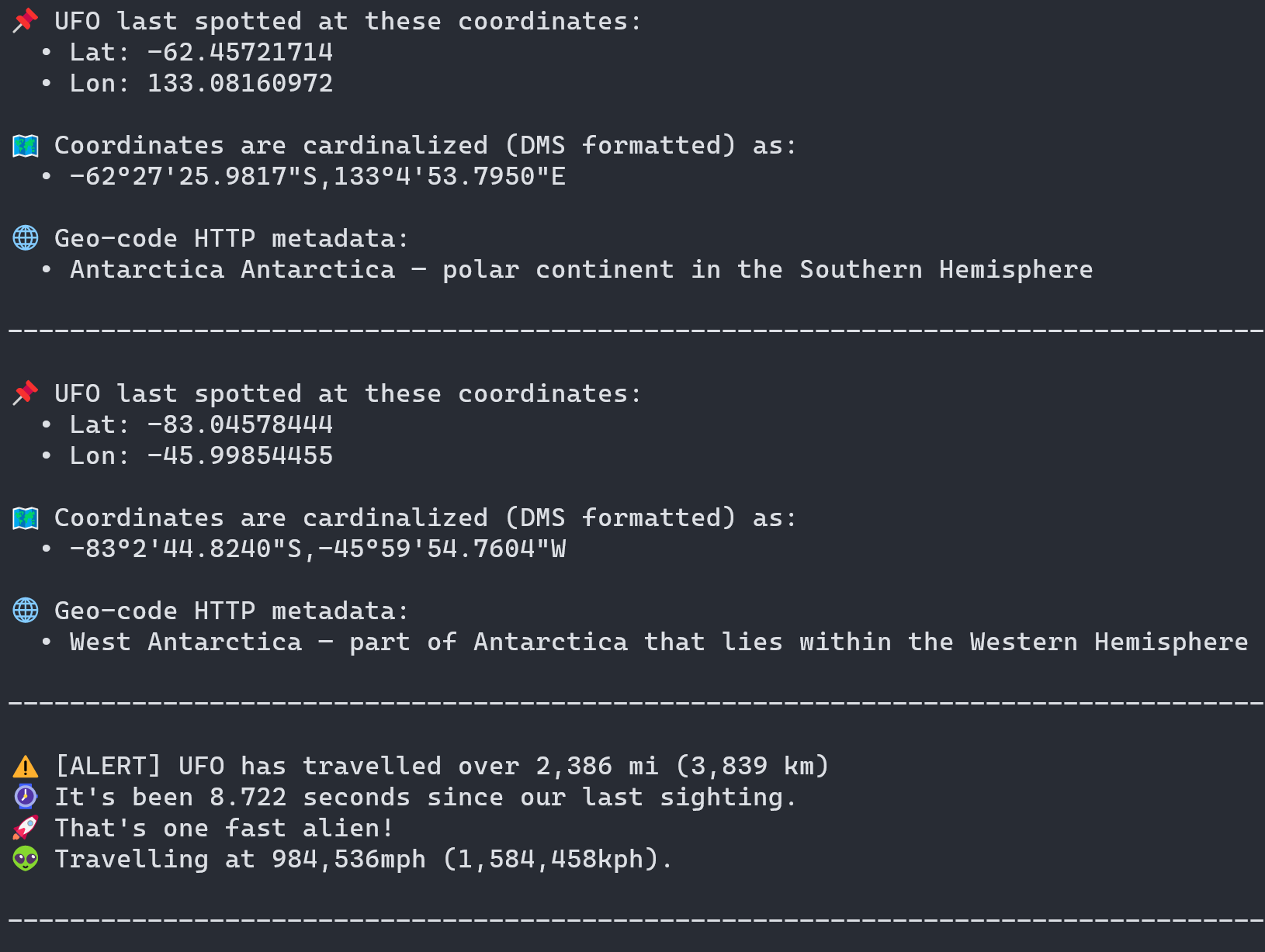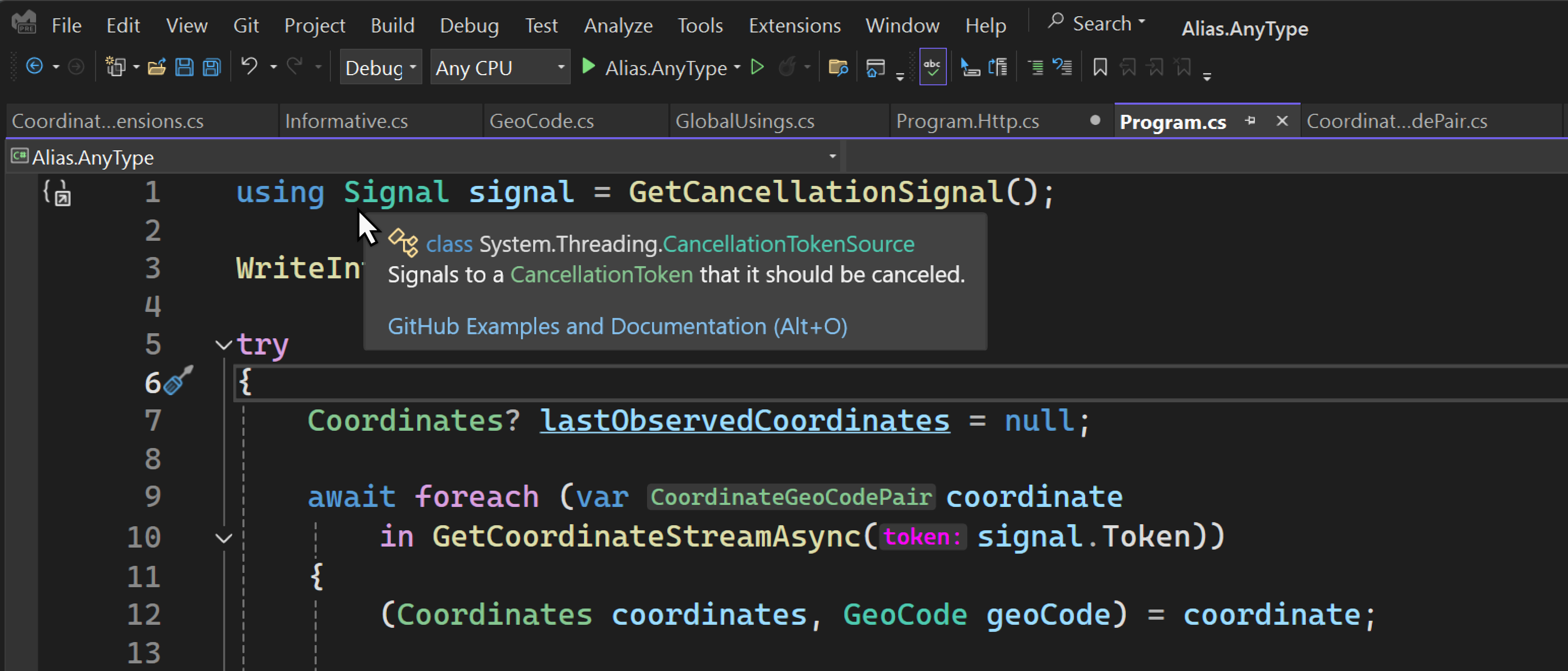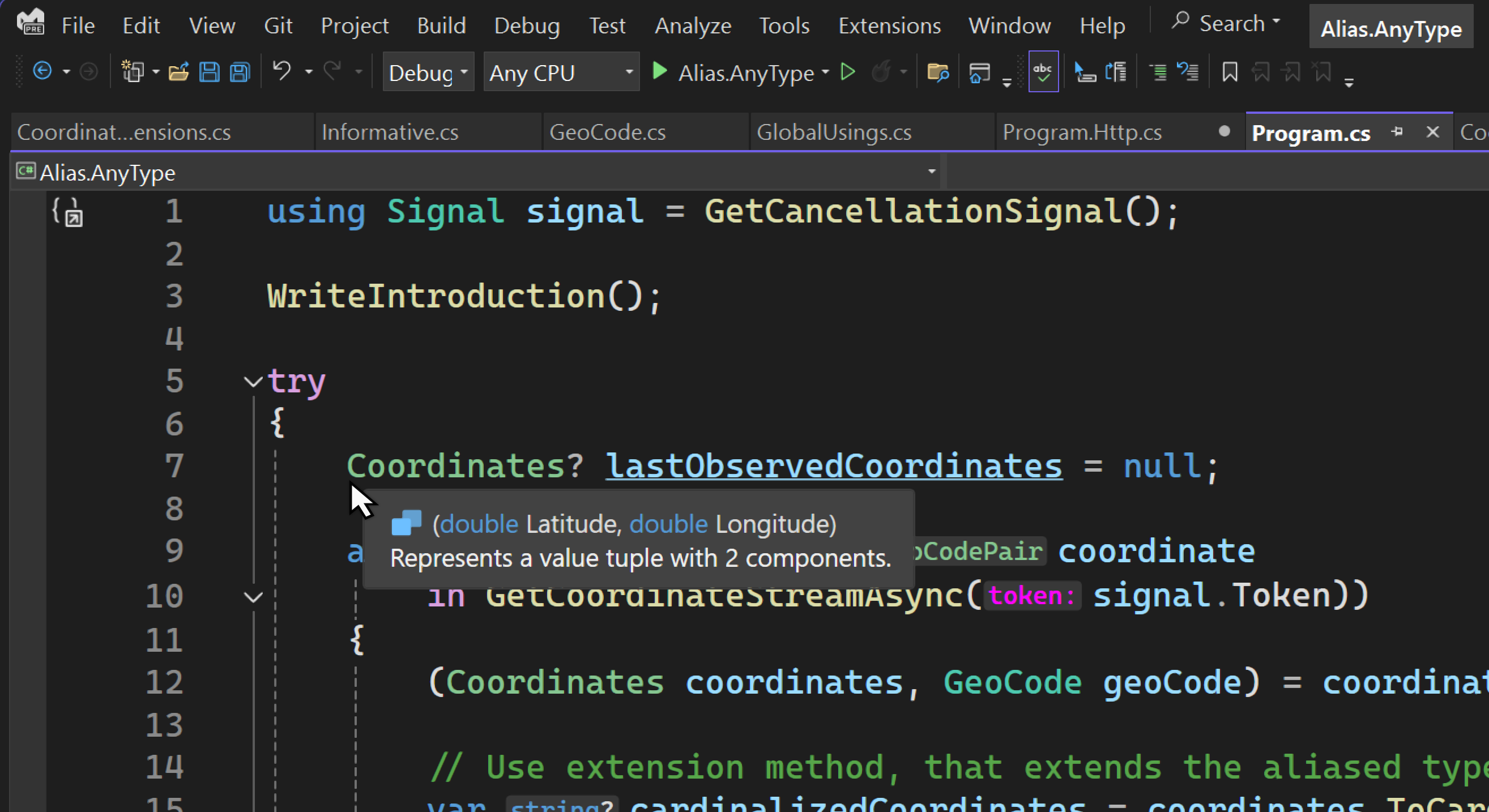This post is the third in a series of four posts, exploring various C# 12 features. In this post, we’ll dive into the “alias any type” feature, which allows you to create an alias for any type with the using directive. This series is really starting to shape up nicely:
- Refactor your C# code with primary constructors
- Refactor your C# code with collection expressions
- Refactor your C# code by aliasing any type (this post)
- Refactor your C# code to use default lambda parameters
All of these features continue our journey to make our code more readable and maintainable, and these are considered “Everyday C#” features that developers should know. Let’s dive in!
Alias Any Type *️⃣
C# 12 introduced the ability to alias any type with the using directive. This feature allows you to specify aliases that map to other types. This includes tuple types, pointer types, array types, and even non-open generic types, all of which are then available in your code. This feature is especially useful:
- When working with long or complex type names.
- When you need to disambiguate types and resolve potential naming conflicts.
- When defining value tuple types that you intend to share in an assembly.
- When you want to add clarity to your code by using more descriptive names.
The official C# documentation is great at providing many examples of how to use this feature, but rather than repeating those samples here, I decided to write a demo app that exemplifies various aspects of the feature.
Nullable reference types
This feature supports most types, with the single exception of nullable reference types. That is, you cannot alias a nullable reference type, and the C# compiler reports an error of CS9132: Using alias cannot be a nullable reference type. The following bits were lifted from the feature specification to help clarify this point:
// This is not legal.
// Error CS9132: Using alias cannot be a nullable reference type
using X = string?;
// This is legal.
// The alias is to `List<...>` which is itself not a nullable
// reference type itself, even though it contains one as a type argument.
using Y = System.Collections.Generic.List<string?>;
// This is legal.
// This is a nullable *value* type, not a nullable *reference* type.
using Z = int?;Sample App: UFO Sightings 🛸
The demo app is available on GitHub at IEvangelist/alias-any-type. It’s a simple console app that emulates unidentified flying object (UFO) sightings. If you want to follow along locally, you can do so with any of the following methods in a working directory of your choice:
Using the Git CLI:
git clone https://github.com/IEvangelist/alias-any-type.gitUsing the GitHub CLI:
gh repo clone IEvangelist/alias-any-typeDownload the zip file:
If you’d rather download the source code, a zip file is available at the following URL:
To run the app, from the root directory execute the following .NET CLI command:
dotnet run --project ./src/Alias.AnyType.csprojWhen the app starts, it prints an introduction to the console—and waits for user input before continuing.

After pressing any key, for example the Enter key, the app randomly generates valid coordinates (latitude and longitude), then using said coordinates retrieves geo-code metadata related to the coordinates. The coordinates are represented in degrees-minutes-seconds format (including cardinality). And when the app is running, distances between the generated coordinates are calculated and reported as UFO sightings.

To stop the app, press the Ctrl + C keys.
While this app is simple, it does include other bits of C# that aren’t necessarily relevant to our focus for this post. I’ll be sure to keep peripheral topics light, but touch on them when I think they’re important.
Code Walkthrough 👀
We’ll use this section to walk the codebase together. There are several interesting aspects of the code that I’d like to highlight, including the project file, GlobalUsings.cs, some extensions, and the Program.cs file. Of the code available, there’s a few things that we’re not going to cover, for example the response models and several of the utilitarian methods.
└───📂 src
├───📂 Extensions
│ └─── CoordinateExtensions.cs
├───📂 ResponseModels
│ ├─── GeoCode.cs
│ ├─── Informative.cs
│ └─── LocalityInfo.cs
├─── Alias.AnyType.csproj
├─── CoordinateGeoCodePair.cs
├─── GlobalUsings.cs
├─── Program.cs
├─── Program.Http.cs
└─── Program.Utils.csLet’s start by looking at the project file:
<Project Sdk="Microsoft.NET.Sdk">
<PropertyGroup>
<OutputType>Exe</OutputType>
<TargetFramework>net8.0</TargetFramework>
<ImplicitUsings>enable</ImplicitUsings>
<Nullable>enable</Nullable>
</PropertyGroup>
<ItemGroup>
<Using Include="System.Console" Static="true" />
<Using Include="System.Diagnostics" />
<Using Include="System.Net.Http.Json" />
<Using Alias="AsyncCancelable"
Include="System.Runtime.CompilerServices.EnumeratorCancellationAttribute" />
<Using Include="System.Text" />
<Using Include="System.Text.Json.Serialization" />
<Using Include="System.Text.Json" />
</ItemGroup>
</Project>The first thing to note here, is that the ImplicitUsings property is set to enable. This feature has been around since C# 10 and it enables the target SDK (in this case the Microsoft.NET.Sdk) to implicitly include a set of namespaces by default. Different SDKs include different default namespaces, for more information, see the Implicit using directives documentation.
Implicit Using Directives 📜
The ImplicitUsing element is a feature of MS Build, whereas the global keyword is a feature of C# the language. Since we’ve opted into global using functionality, we can also take advantage of this feature by adding our own directives. One way to add these directives is by adding Using elements within an ItemGroup. Some using directives are added with the Static attribute set to true, which means all of their static members are available without qualification—more on this later. The Alias attribute is used to create an alias for a type, in this example we’ve specified an alias of AsyncCancelable for the System.Runtime.CompilerServices.EnumeratorCancellationAttribute type. In our code, we can now use AsyncCancelable as a type alias for EnumeratorCancellation attribute. The other Using elements create non-static and non-aliased global using directives for their corresponding namespaces.
An Emerging Pattern 🧩
We’re starting to see a common pattern emerge in modern .NET codebases where developers define a GlobalUsings.cs file to encapsulate all (or most) using directives into a single file. This demo app follows this pattern, let’s take a look at the file next:
// Ensures that all types within these namespaces are globally available.
global using Alias.AnyType;
global using Alias.AnyType.Extensions;
global using Alias.AnyType.ResponseModels;
// Expose all static members of math.
global using static System.Math;
// Alias a coordinates object.
global using Coordinates = (double Latitude, double Longitude);
// Alias representation of degrees-minutes-second (DMS).
global using DMS = (int Degree, int Minute, double Second);
// Alias representation of various distances in different units of measure.
global using Distance = (double Meters, double Kilometers, double Miles);
// Alias a stream of coordinates represented as an async enumerable.
global using CoordinateStream = System.Collections.Generic.IAsyncEnumerable<
Alias.AnyType.CoordinateGeoCodePair>;
// Alias the CTS, making it simply "Signal".
global using Signal = System.Threading.CancellationTokenSource;Everything in this file is a global using directive, making the alias types, static members, or namespaces available throughout the entire project. The first three directives are for common namespaces, which are used in multiple places throughout the app. The next directive is a global using static directive for the System.Math namespace, which makes all of static members of Math available without qualification. The remaining directives are global using directives that create aliases for various types, including several tuples, a stream of coordinates, and a CancellationTokenSource that’s now simply referable via Signal.
One thing to consider is that when you define a tuple alias type, you can easily pivot later to a record type if you need to add behavior or additional properties. For example, later on you might determine that you’d really like to add some functionality to the Coordinates type, you could easily change it to a record type:
namespace Alias.AnyType;
public readonly record struct Coordinates(
double Latitude,
double Longitude);When you define an alias, you’re not actually creating a type, but rather a name that refers to an existing type. In the case of defining tuples, you’re defining the shape of a value tuple. When you alias an array type, you’re not creating a new array type, but rather aliases the type with perhaps a more descriptive name. For example, when I define an API that returns an IAsyncEnumerable<CoordinateGeoCodePair>, that’s a lot to write. Instead, I can now refer to it the return type as CoordinateStream throughout my codebase.
Referencing Aliases 📚
There were several aliases defined, some in the project file and others in the GlobalUsings.cs file. Let’s look at how these aliases are used in the codebase. The start by looking at the top-level Program.cs file:
using Signal signal = GetCancellationSignal();
WriteIntroduction();
try
{
Coordinates? lastObservedCoordinates = null;
await foreach (var coordinate
in GetCoordinateStreamAsync(signal.Token))
{
(Coordinates coordinates, GeoCode geoCode) = coordinate;
// Use extension method, that extends the aliased type.
var cardinalizedCoordinates = coordinates.ToCardinalizedString();
// Write UFO coordinate details to the console.
WriteUfoCoordinateDetails(coordinates, cardinalizedCoordinates, geoCode);
// Write travel alert, including distance traveled.
WriteUfoTravelAlertDetails(coordinates, lastObservedCoordinates);
await Task.Delay(UfoSightingInterval, signal.Token);
lastObservedCoordinates = coordinates;
}
}
catch (Exception ex) when (Debugger.IsAttached)
{
// https://x.com/davidpine7/status/1415877304383950848
_ = ex;
Debugger.Break();
}The preceding code snippet shows how the Signal alias is used to create a CancellationTokenSource instance. As you may know, the CancellationTokenSource class is an implementation of IDisposable, that’s why we can use the using statement to ensure that the Signal instance is properly disposed of when it goes out of scope. Your IDE understands these aliases, and when you hover over them, you’ll see the actual type that they represent. Consider the following screen capture:

The introduction is written to the console from the WriteIntroduction call, just before entering a try / catch. The try block contains an await foreach loop that iterates over an IAsyncEnumerable<CoordinateGeoCodePair>. The GetCoordinateStreamAsync method is defined in a separate file. I find myself leveraging partial class functionality more often when I write top-level programs, as it helps to isolate concerns. All of the HTTP-based functionality is defined in the Program.Http.cs file, let’s focus on the GetCoordinateStreamAsync method:
static async CoordinateStream GetCoordinateStreamAsync(
[AsyncCancelable] CancellationToken token)
{
token.ThrowIfCancellationRequested();
do
{
var coordinates = GetRandomCoordinates();
if (await GetGeocodeAsync(coordinates, token) is not { } geoCode)
{
break;
}
token.ThrowIfCancellationRequested();
yield return new CoordinateGeoCodePair(
Coordinates: coordinates,
GeoCode: geoCode);
}
while (!token.IsCancellationRequested);
}You’ll notice that it returns the CoordinateStream alias, which is an IAsyncEnumerable<CoordinateGeoCodePair>. It accepts an AsyncCancelable attribute, which is an alias for the EnumeratorCancellationAttribute type. This attribute is used to decorate the cancellation token such that it’s used in conjunction with IAsyncEnumerable to support cancellation. While cancellation isn’t requested, the method generates random coordinates, retrieves geo-code metadata, and yields a new CoordinateGeoCodePair instance. The GetGeocodeAsync method requests the geo-code metadata for the given coordinates, and if successful, it returns the GeoCode response model. For example, Microsoft Campus has the following coordinates:
GET /data/reverse-geocode-client?latitude=47.637&longitude=-122.124 HTTP/1.1
Host: api.bigdatacloud.net
Scheme: httpsTo see the JSON, open this link in your browser. The CoordinateGeoCodePair type is not aliased, but it’s a readonly record struct that contains a Coordinates and a GeoCode:
namespace Alias.AnyType;
internal readonly record struct CoordinateGeoCodePair(
Coordinates Coordinates,
GeoCode GeoCode);Going back to the Program class, when we’re iterating each coordinate geo-code pair, we deconstruct the tuple into Coordinates and GeoCode instances. The Coordinates type is an alias for a tuple of two double values representing the latitude and longitude. Again, hover over this type in your IDE to quickly see the type, consider the following screen capture:

The GeoCode type is a response model that contains information about the geo-code metadata. We then use an extension method to convert the Coordinates to a cardinalized string, which is a string representation of the coordinates in degrees-minutes-seconds format. I personally, love how easy it is to use aliases throughout your codebase. Let’s look at some of the extension methods that extend or return aliased types:
internal static string ToCardinalizedString(this Coordinates coordinates)
{
var (latCardinalized, lonCardinalized) = (
FormatCardinal(coordinates.Latitude, true),
FormatCardinal(coordinates.Longitude, false)
);
return $"{latCardinalized},{lonCardinalized}";
static string FormatCardinal(double degrees, bool isLat)
{
(int degree, int minute, double second) = degrees.ToDMS();
var cardinal = degrees.ToCardinal(isLat);
return $"{degree}°{minute}'{second % 60:F4}\"{cardinal}";
}
}This extension method, extends the Coordinates alias type and return a string representation of the coordinates. It uses the ToDMS extension method to convert the latitude and longitude to degrees-minutes-seconds format. The ToDMS extension method is defined as follows:
internal static DMS ToDMS(this double coordinate)
{
var ts = TimeSpan.FromHours(Abs(coordinate));
int degrees = (int)(Sign(coordinate) * Floor(ts.TotalHours));
int minutes = ts.Minutes;
double seconds = ts.TotalSeconds;
return new DMS(degrees, minutes, seconds);
}If you recall, the DMS alias is a tuple of three values representing degrees, minutes, and seconds. The ToDMS extension method takes a double value and returns a DMS tuple. The ToCardinal extension method is used to determine the cardinal direction of the coordinate, returning either N, S, E, or W. The Abs, Sign, and Floor methods are all static members of the System.Math namespace, which is aliased in the GlobalUsings.cs file.
Beyond that, the app displays the UFO sighting details to the console, including the coordinates, geo-code metadata, and the distance traveled between sightings. This occurs on repeat, until the user stops the app with a Ctrl + C key combination.
Next steps 🚀
Be sure to try this out in your own code! Check back soon for the last post in the series, where we’ll explore default lambda parameters. To continue learning more about this feature, checkout the following resources:


Is it possible to have a single global using file for the entire solution — that is, for all projects without having to create one for each project?
Any C# file has only scope of the project it's included into, there is no some "special" C# file. Therefore, you have two workarounds: 1. Link the same shared GlobalUsings.cs file in multiple projects (it can be located in one of the projects' directory or in some solution-level folder) . Or 2. Use Directory.Build.props file to define solution-wide global usings in project file format (like shown in the article). You can also use third approach as a hybrid of the first two: link shared GlobalUsings.cs into all projects using Directory.Build.props file, so you don't have to modify every project.
It would be awesome if the following code worked:
If you have a complex enough set of aliases, you must copy-paste the same expressions many times.
using Alias<T1, T2, T3> = ..namesps…Class1<…namesps..Class2<T1>, ….namesps..Class3<T2, T3>>